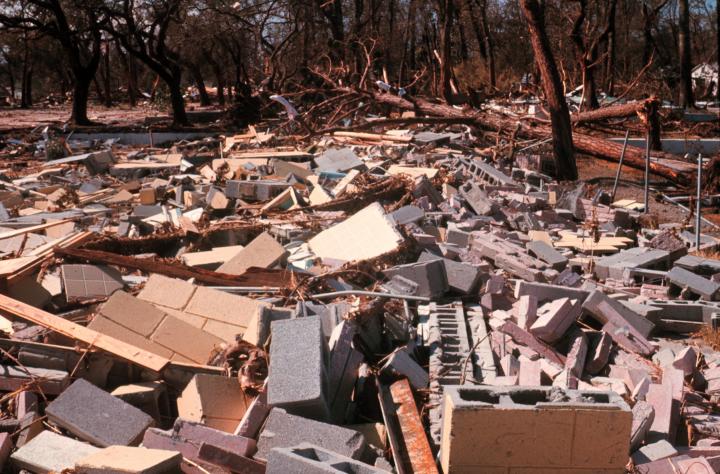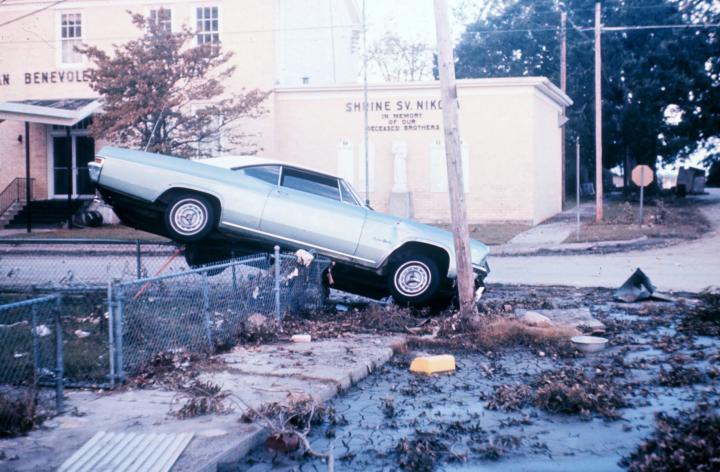
Rhode Island’s Edgewood Yacht Club withstands the storm surge from Hurricane Carol.
Hurricanes of the Late 1900s
ADVERTISEMENT
Hello. Ever since I was old enough to understand hurricanes and growing up in Antigua in the Caribbean I have always wanted to have a hurricane name after me. (Cerene). Was there ever one by that name. How do I get one name after me!.
You have hurricane Camille making landfall August 1, actually it made landfall August 17, 1969.
I and younger brother Jack Breland ,lived in Long Beach,Ms ,We road the storm out in a tree on August 19, 1969 ,Im Gerald Breland. Here is my story, We lived one house off the beach on Nicholson Ave. The storm came in around 6 pm the 19th ,me and my brother got into our families attic, in about an hour water or so house was shaking on foundation , we could smell gas, so we decided to leave our house. The water was about waist deep at that time. We tide a rope together around us,there was no swimming we crawled over trash and debris..broke into our neighbors house and climbed up into there attic .when the front of there house ripped off almost trapping us inside,we climbed out onto the roof and lay flat,the wind then blew the roof off ,we flew though air and landed on trash,got on a underside roof into a tree ,by 1145 pm 19th August 1969,by day light sun came our home gone, a block off the beach...will never forget that night,,thank Go
Hurricane Hugo made landfall in the U.S. Virgin Islands before the Carolinas. Leveling homes and businesses causing St.Croix to be a disaster area. It took years for the island to recover. Some of the damage done by Hugo was never repaired.
What about Hurricane George and Marilyn? They hit the Caribbean back to back in 1995.
Hi, Beverly: Excellent points, and thanks for pointing out George and Marilyn! And while they no doubt would have made a fetching (and deserving) couple to add to our list, there just was not enough room at this party to invite everyone to our page. We do appreciate the input, though, and will certainly keep them in mind. Thanks again!
Was their a hurricane name Matthew.and are their ever going to be a hurricane name Cathy.and who names the hurricane.
Hurricane Matthew was the first Category 5 Atlantic hurricane since Hurricane Felix in 2007, and also caused catastrophic damage and a humanitarian crisis in Haiti, as well as widespread devastation in the southeastern United States. Wikipedia
Total fatalities: 603
Dates: Sep 28, 2016 – Oct 10, 2016
Date: September 28, 2016 – October 10, 2016
Damage: $15.09 billion (2016 USD)
Category: Category 5 Hurricane (SSHWS)
Affected areas: North Carolina, South Carolina, Venezuela, Cuba, MORE
We experienced it hitting approximately 40 mi north of Wilmington, NC. At that time it was a category 2 hurricane. While it did not affect us horribly, it went inland and flooded central NC causing prolonged and catastrophic flooding.
I'm feeling a certain type of way about the last comment and it's reply. An article on Hurricane Katrina needs to be written on this site, if it hasn't been already. It is one of the biggest & destructive hurricanes ever recorded. It remains, much apart of 'American History' and that is what Ms. Seal was trying to make mention. 20th century hurricanes? Okay, we got it. Let's move on.
You’re right, Hurricane Katrina was indeed the most costly hurricane in US history and has affected many lives. We talk about Katrina and other 21st-century hurricanes here: Worst Hurricanes in American History (Part III): Hurricanes of the Early 2000s












